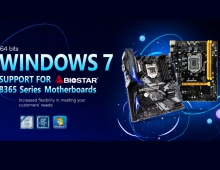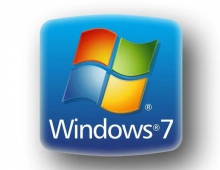
Microsoft Introduces Windows 7 to Hardware Partners
At the Windows Hardware
Engineering Conference (WinHEC) 2008, Microsoft showcased new faetures in Windows 7 that make it easier for hardware partners to create new products for Windows PC customers.
Windows senior vice presidents Steven Sinofsky and Jon DeVaan encouraged hardware partners to start testing their current products and building new products on the application programming interface (API) complete pre-beta that was distributed to WinHEC attendees. Microsoft also provided a pre-beta release of Windows Server 2008 R2 to attendees.
Microsoft demonstrated new features in Windows 7 that optimize how customers interact with Windows PCs, manage devices, access broadband and engage with wireless experiences. The following features in particular were highlighted:
- Devices and Printers. Microsoft has created a new feature in Windows 7 called Devices and Printers. Devices and Printers provides a single place for customers to interact with devices, browse files or manage settings. Devices can be connected to the PC using USB, Bluetooth or Wi-Fi, with wizards that simply the setup process.
- Device Stage. Device Stage enables hardware manufactures to create an even richer user experience, especially for more specialized devices such as cell phones, multifunction printers and digital cameras. Device Stage is designed to help Windows 7 customers take advantage of advanced features for devices. For mobile phones, portable media players, cameras and printers connected to a Windows 7 PC, Device Stage provides information on the device status and runs common tasks in a single window customized by the device manufacturer.
- Mobile broadband. Windows 7 delivers a simpler and more reliable way to connect to the Internet using wireless modems. The process is similar to connecting to any other wireless network, and is done using the View Available Networks feature. A consistent experience for customers and a common infrastructure for partners enables lower support, maintenance, deployment and management costs, and allows partners to focus on higher-value services rather than basic connectivity development.
- Windows Touch. Controlling the computer by touching the screen is a core part of the Windows 7 experience, with visual feedback provided for tap and double-tap gestures. The Start menu, Windows Taskbar and Windows Explorer are touch-ready. Windows 7 also introduces support for multitouch technology, which enables customers to control what happens on the screen in new ways by zooming in, zooming out and rotating images with their fingers.
Microsoft also announced early industry support for Device Stage from partners including Brother, Epson, HP, Motorola, Nikon, Sansa, Canon and Sony.
As part of the keynote, Microsoft demonstrated Canon?s SD990 digital camera and a Nokia N95 smartphone to show how Device Stage makes it easier for people to use multifunction devices and makes it easier for hardware companies to package custom applications and services as part of the user experience.
Windows Server 2008 R2
Also at WinHEC, Microsoft will be demonstrating Windows Server 2008 R2 to attendees. Microsoft is working with original equipment manufacturers, independent software vendors and developers to help ensure that customers can make full use of the latest industry hardware advancements in 64-bit, as well as multicore and manycore processing and power management efficiencies, with Windows Server 2008 R2.
Microsoft is working on an update release for Windows Server, named Windows Server 2008 R2. As part of this update, Microsoft is integrating the latest service and feature packs with some new technology investments focused around four categories: virtualization, management, scalability and the Web.
From a virtualization standpoint, Microsoft is working on a newer version of its Hyper-V hypervisor technology as well as some new features, such as Live Migration. This feature, which is included with Windows Server 2008 R2 at no additional charge, lets you move a running workload from one machine to another in milliseconds, with no loss of performance from the user?s point of view.
On the management front, Windows Server 2008 R2 will give customers the reins to manage their servers the way they desire, whether that is locally or remotely, via a graphical user interface (GUI) or from the command line via Windows PowerShell. The company is also making improvements to help customers reduce and better manage their datacenter power consumption. Windows Server 2008 R2 can automatically turn processor cores on and off based on the workload of the system, or reduce the power consumption by adjusting processor speed.
Another area of innovation in Windows Server 2008 R2 is the ability to more easily administer and support Web applications on a streamlined Web platform. Microsof thas integrated Internet Information Services 7.0 (IIS) manager extensions to make it simpler to administer local and remote Web servers, and added support for ASP.NET and PHP to the Server Core.
And finally, in Windows Server 2008 R2, Microsoft has built in support for up to 256 logical processors.
At WinHEC, Microsoft encouraged attendees to try out the pre-beta Windows Server 2008 R2 code, known as Milestone 3. On Nov. 12, the company will launch Windows Small Business Server 2008 and Windows Essential Business Server 2008, which are all-in-one solutions that address key small- and midsize-customers.
Microsoft demonstrated new features in Windows 7 that optimize how customers interact with Windows PCs, manage devices, access broadband and engage with wireless experiences. The following features in particular were highlighted:
- Devices and Printers. Microsoft has created a new feature in Windows 7 called Devices and Printers. Devices and Printers provides a single place for customers to interact with devices, browse files or manage settings. Devices can be connected to the PC using USB, Bluetooth or Wi-Fi, with wizards that simply the setup process.
- Device Stage. Device Stage enables hardware manufactures to create an even richer user experience, especially for more specialized devices such as cell phones, multifunction printers and digital cameras. Device Stage is designed to help Windows 7 customers take advantage of advanced features for devices. For mobile phones, portable media players, cameras and printers connected to a Windows 7 PC, Device Stage provides information on the device status and runs common tasks in a single window customized by the device manufacturer.
- Mobile broadband. Windows 7 delivers a simpler and more reliable way to connect to the Internet using wireless modems. The process is similar to connecting to any other wireless network, and is done using the View Available Networks feature. A consistent experience for customers and a common infrastructure for partners enables lower support, maintenance, deployment and management costs, and allows partners to focus on higher-value services rather than basic connectivity development.
- Windows Touch. Controlling the computer by touching the screen is a core part of the Windows 7 experience, with visual feedback provided for tap and double-tap gestures. The Start menu, Windows Taskbar and Windows Explorer are touch-ready. Windows 7 also introduces support for multitouch technology, which enables customers to control what happens on the screen in new ways by zooming in, zooming out and rotating images with their fingers.
Microsoft also announced early industry support for Device Stage from partners including Brother, Epson, HP, Motorola, Nikon, Sansa, Canon and Sony.
As part of the keynote, Microsoft demonstrated Canon?s SD990 digital camera and a Nokia N95 smartphone to show how Device Stage makes it easier for people to use multifunction devices and makes it easier for hardware companies to package custom applications and services as part of the user experience.
Windows Server 2008 R2
Also at WinHEC, Microsoft will be demonstrating Windows Server 2008 R2 to attendees. Microsoft is working with original equipment manufacturers, independent software vendors and developers to help ensure that customers can make full use of the latest industry hardware advancements in 64-bit, as well as multicore and manycore processing and power management efficiencies, with Windows Server 2008 R2.
Microsoft is working on an update release for Windows Server, named Windows Server 2008 R2. As part of this update, Microsoft is integrating the latest service and feature packs with some new technology investments focused around four categories: virtualization, management, scalability and the Web.
From a virtualization standpoint, Microsoft is working on a newer version of its Hyper-V hypervisor technology as well as some new features, such as Live Migration. This feature, which is included with Windows Server 2008 R2 at no additional charge, lets you move a running workload from one machine to another in milliseconds, with no loss of performance from the user?s point of view.
On the management front, Windows Server 2008 R2 will give customers the reins to manage their servers the way they desire, whether that is locally or remotely, via a graphical user interface (GUI) or from the command line via Windows PowerShell. The company is also making improvements to help customers reduce and better manage their datacenter power consumption. Windows Server 2008 R2 can automatically turn processor cores on and off based on the workload of the system, or reduce the power consumption by adjusting processor speed.
Another area of innovation in Windows Server 2008 R2 is the ability to more easily administer and support Web applications on a streamlined Web platform. Microsof thas integrated Internet Information Services 7.0 (IIS) manager extensions to make it simpler to administer local and remote Web servers, and added support for ASP.NET and PHP to the Server Core.
And finally, in Windows Server 2008 R2, Microsoft has built in support for up to 256 logical processors.
At WinHEC, Microsoft encouraged attendees to try out the pre-beta Windows Server 2008 R2 code, known as Milestone 3. On Nov. 12, the company will launch Windows Small Business Server 2008 and Windows Essential Business Server 2008, which are all-in-one solutions that address key small- and midsize-customers.





















